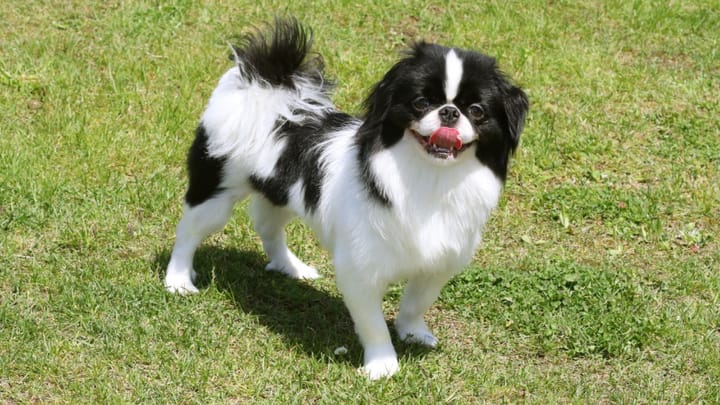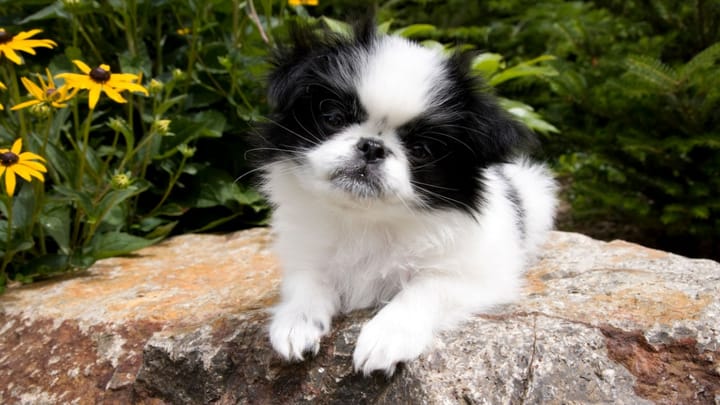Japanese Chin
Other names : Japanese Spaniel, Chin


This peculiar little dog hails not from Japan, although the breed has certainly done well there, but from China. The word ‘chin’ signifies ‘cat-like,’ and indeed this lady is one of the cattiest of dogs. The Chin climbs like a cat (if she can’t quite match the cat’s agility) and is just as likely to snooze on the the back of your sofa as on the cushion ; she grooms herself with her paws, and can even be said to have a cat-like face, through which she snorts and sneezes in a disturbing but generally harmless manner.
|
Life expectancy |
The Japanese Chin has a life expectancy of between 12 and 14 years |
|
Temperament |
|
|
Size |
Small
|
|
Adult size |
Female
Between 9 and 9 in
Male
Between 9 and 10 in
|
|
Adult weight |
Female
Between 7 and 9 lb
Male
Between 7 and 9 lb
|
|
Coat colour
White with black and/or red symmetrical markings. |
Black White Red |
|
Type of coat
The Japanese Chin's hair length is of medium length. Its type of coat is silky and single coated. |
Long |
|
Eye colour
Black. |
Brown
|
|
Purchase price |
The Japanese Chin costs between £570 and £735 |
She likes to entertain with tricks, such as the ‘Chin Spin’ or windmill, and dancing on her back legs.
More details about the Japanese Chin
Japanese Chin: Origins and history
The Chin can trace her lineage back over hundreds of years, to when Chinese traders travelled the Silk Road with little dogs whom they would sometimes leave behind or give to the Buddhist monasteries they passed. The monks bred the animals so that they evolved into a similar creature to that we see today; her figure can be spotted on ancient pottery, embroidery, and on temple walls. Travelling dignitaries would acquire the dogs when they passed through the monasteries, and made gifts of them to royal courts, where they would be treated like royalty themselves, their every whim catered to by eunuchs. She first found her way to Europe in the mid-19th century; Queen Victoria had a fine pair. Today she has become very popular in the east and west alike.
Physical characteristics of the Japanese Chin
A well-kept Chin is a sight to behold : she looks like she’s been drenched in a downpour of loveliness. Her silky white hair smooths out any hard angles and fills in much of the space between her legs, and a puffy tail curls up and over her back, evening up the gap behind her head, with the overall effect of making her a perfect fluffy square. Her snout is short and broad, her eyes big and wide apart, and they have the appearance of being slightly crossed due to a spread of white towards the middle. All in all, then, she looks every part the inbred aristocrat, precious and aloof, deluxe but undesirable.
FCI classification of the Japanese Chin
-
Group 9 - Companion and Toy Dogs
-
Section 8 : Japan Chin and Pekingese
Japanese Chin: Characteristics
Japanese Chin: Behaviour
Training a Japanese Chin
If you’ve ever tried to train a cat, you can imagine what this little princess’s education is going to look like. While she’s bright enough to pick things up, her independent streak can make it tough to convey lessons to her. Patience and time are needed, and above all the pedagogue should be careful not to give in to suggestions that the dog, rather than the human, holds authority within the pack.
Japanese Chin: Lifestyle
Breed compatibility Japanese Chin
Japanese Chin: Purchase price
The average price for a Japanese Chin dog is between £570 - £735.
The Japanese Chin can cost around £25 - £40 per month to feed and maintain.
Japanese Chin: Shedding
Average
Most of the time her fur does not cause as much litter as you might expect, but once or twice a year she will shed more severely, at which point you will be very grateful you bought that DustBuster that’s been under the stairs since the 1980s.
Japanese Chin: Grooming
She may look grooming-intensive, but it doesn’t actually take too much work to keep the Chin looking and feeling handsome. Brush her once a week; bathe her once a month; and clip her nails regularly. More regular brushing or combing is to be encouraged if the owner has time, particularly to avoid tangles and to keep the feathered parts looking fresh and alluring. More regular baths, however, should only be taken if necessary, as they can dry out the princess’s delicate skin. Don’t forget that, in her catlike way, the Chin will attend to a certain level of personal hygiene herself. Special attentions should be paid to the ears and nose, which are prone to build up dirt, wax, and bacteria due to their foldy nature. This should be performed by the human, since dogs cannot generally operate cotton-buds.
Japanese Chin: Health
12-14 years.
While no twiglet, the Chin was built for pleasure, not graft; she should not be put to work or left out overnight, and may snap in the hands of an anarchistic toddler.
Due to her brachycephalic face, the Chin will soon become uncomfortable in anything approaching hot weather. She should be kept somewhere cool, given plenty of fresh water, and fanned with a giant palm leaf if the temperature exceeds expectations, as indeed it frequently will as humankind begins the slow decline towards extinction along the path of climate change.
Extreme cold can also trouble this pug-nosed little princess, but not so much as the hot weather.
While the Chin herself does not tend towards gluttony, it’s all too easy to over-treat and under-exercise her, in which case weight-gain is the inevitable outcome.
- Patella luxation
- Hypoglycemia
- Allergies
- Legg-Calve-Perthes disease
- Hip and elbow dysplasia
- Hypothyroidism
- Von Willebrand's disease
- Gangliosidosis






